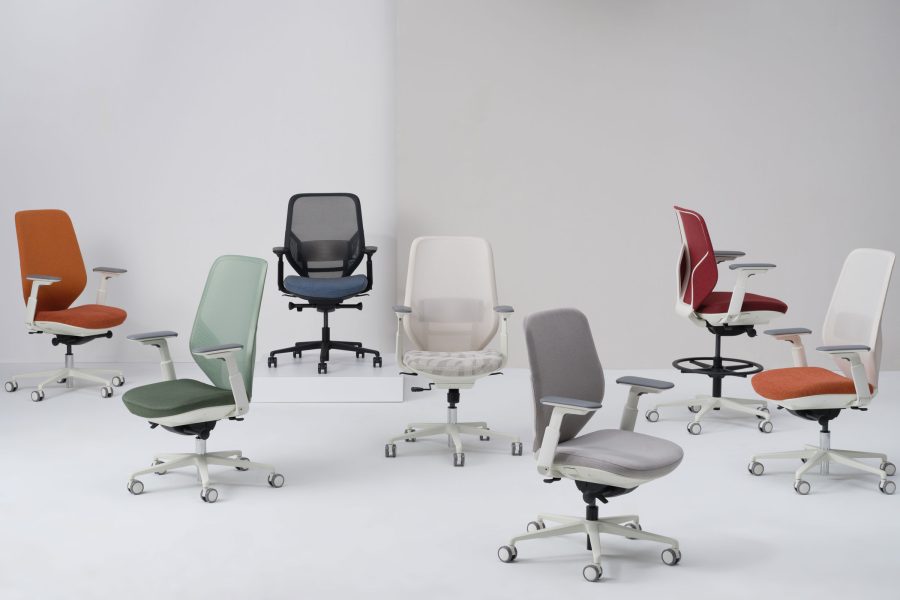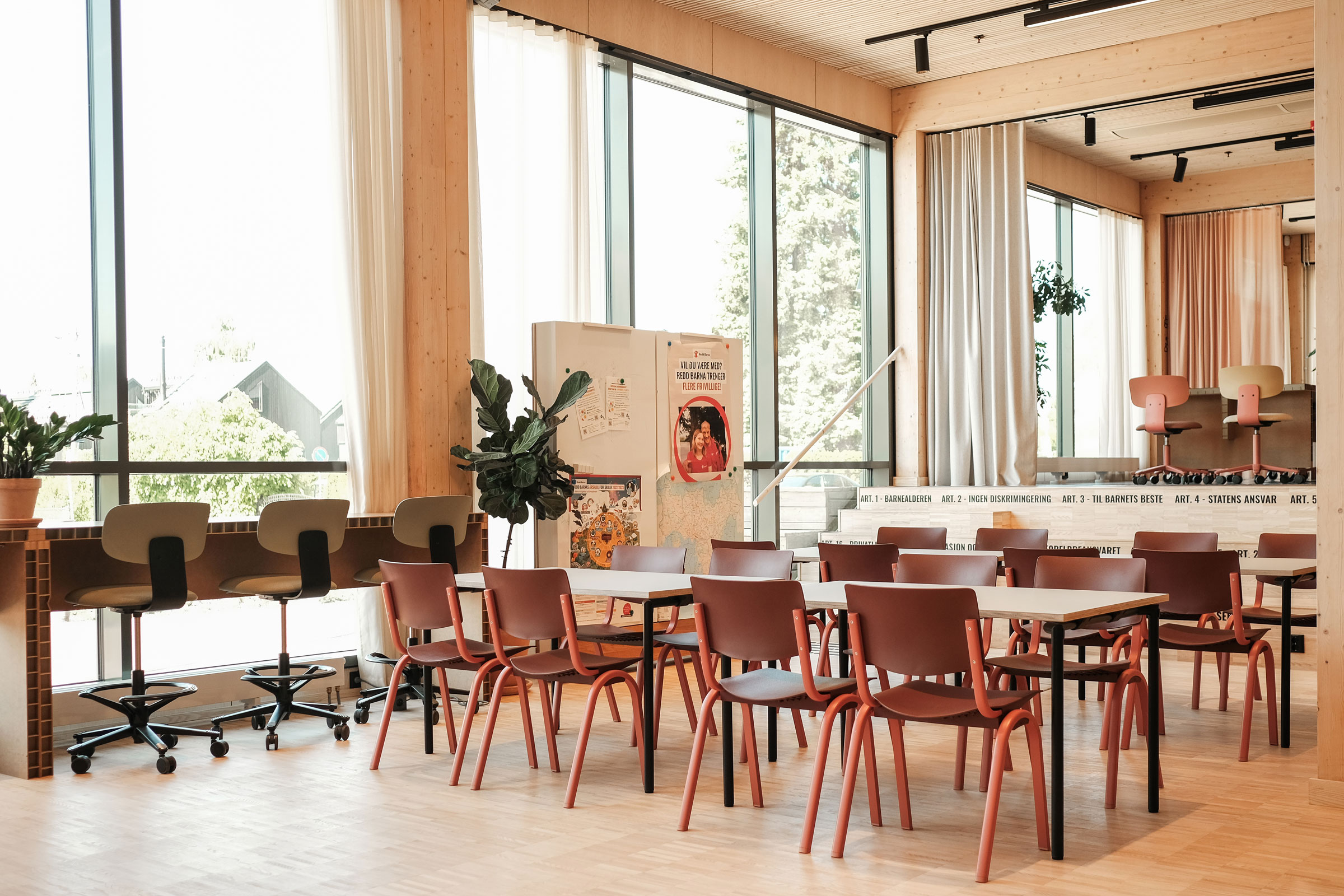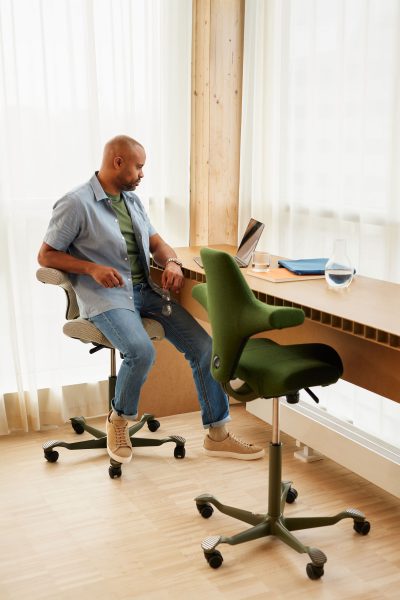Story at a glance:
- Collaboration and face time are standout benefits of a return to the office—and offer ample opportunity for innovative and adaptable office design.
- 9to5 Seating focuses efforts on sustainability and comfort to ensure the people who sit down are productive and inspired by their environment.
- Perkins&Will notes the changing technologies and economic landscape putting new pressures on workplace design—from AI to adaptive reuse.
Without a doubt the workplace has changed dramatically in the last 10 years. The question of how to design effective, productive, and motivating spaces for everyone who uses an office space today—and 10 years from now, until the end of a lease, and beyond—becomes increasingly difficult to answer with changing attitudes toward work, new technologies, and even the vacillating physical presence of teams in the office.
Considering the trends shaping the workplace, the ideas of face-to-face collaboration, personal comfort, technology, and sustainability stand out as major influences. But really, each of these themes is just a lens through which to view the core concept driving innovation in workplace design: flexibility.
“Flexibility has always been key, and it’s even more important now because it is tied to the ability to offer choice to people. This has become much more important as people return to the office,” says Catherine Heath, Perkins&Will managing principal and northeast regional practice leader for workplace.
Part of that flexibility comes from great workplace furniture, as the most tactile part of the daily user experience. “With the hybrid workstyle you have people coming and going all the time, sitting in the same chair used by others. Those chairs have to be easy to adjust and need to have the right ergonomics so that anyone can sit in the chair and focus in the workplace,” says Mark Mannon, vice president of marketing and product development at 9to5 Seating.
People maintain a wide array of approaches to work, varying across age, industry, and position. The designer’s crucial responsibility is to offer agency to employees in a space, allowing individuals to create their most productive environments.
Collaboration in Flexible Workspaces
- HÅG Capisco’s saddle seat can be adjusted between low and high working positions, all the way up to a standing position. Photo courtesy of HÅG
- A chair like HÅG Capisco offers a dramatic range of adjustment for focused work. Photo courtesy of HÅG
Flex Index, a database cataloging workplace policies, published a report finding that 68% of US firms offered workplace flexibility at the end of 2024, but that the average in-office requirement among hybrid work policies is on a steady rise. While there are a number of reasons companies may want their employees present in office, from the human perspective the primary in-person opportunity is collaboration.
“From the research we’ve done—and we do a lot of research on every project, interviewing the people who are going to occupy the space—by far the most important aspect of why people come into the office is other people,” Heath says. “There’s no point in coming back to an office that, by itself, is isolating. Community spaces and amenity spaces where people can collaborate and get to know each other are where the magic happens.”
These spaces hinge on what Heath calls “persuasive placemaking,” a strategy of rooting spaces in a firm’s mission and ethos. It allows people in a space to feel connected to their environment and to each other by layering life and character into the office design with lighting, materiality, artwork, graphic design, and furniture. The seating becomes an especially crucial element of the placemaking by offering aesthetic, tactile, and physical differentiation between spaces.
“There’s a lot more collaboration in the workflow today. Furniture can facilitate that by being easy to move and reconfigure, like modular lounge furniture that can be easily reconfigured to foster collaboration,” Mannon says. He points to 9to5 seating options like Koble, a modular soft seating system that can be tailored to meet the needs of a communal space.
On the other hand, a chair like HÅG Capisco offers a dramatic range of adjustment for focused work: Sit at desk height, perch at a sit-to-stand desk, add a foot ring to use it more as a stool, turn around and lean forward against the backrest for added stability while peering into a microscope, or draft by hand. “Being adaptable at that tactile level for how people actually do work all day long is really critical,” Heath says.
Personal Comfort at Work

9to5 Seating solutions like Tori are among some of the most comfortable task chairs. Photo courtesy of 9to5 Seating
“When you think about the user experience, furniture has a direct relationship to personal comfort and the ability to work productively,” Heath says. A lot of workplaces today are not assigning stations to individuals, opting instead for a strategy of free address.
This means chairs in the office must be durable, adjustable, and dynamic for all users to sit comfortably.
“Right now the average person sits in 1.4 chairs a day, not just one chair,” Mannon says. “What you sit in has to be comfortable, but it has to be ergonomically supportive, too.” Mannon points out that the cushiest foam doesn’t hold up over time; instead, 9to5 utilizes molded, high-resilience foam for firmer and more durable comfort, particularly in the seats of task chairs like Tori, which Mannon calls out as one of the most comfortable.
In designing Tori, like every 9to5 seat, ANSI/BIFMA provides ergonomic standards—seat height, arm height, and lumbar curve, for example, and then 9to5 Seating is able to add comfort in the molded foam, in the lumbar curve, and in features that promote movement—like flex backs or footrests to encourage movement and blood circulation. For example, 9to5 Seating produces the HÅG Celi. “It rocks as you lean back, which is uncommon for a multipurpose chair,” Mannon says.
“It makes a tactile difference to the people occupying that space. They can feel it if it’s cheap, but if it feels nice, it is almost like a complement to them, like their company saying, “We care about you,” Heath says. Combined with glass walls for light, mission-inspired touches, mixed materiality, biophilic design, and integrated lighting design, furniture helps create a comfortable and adaptable space for employees.
Integrating with Technology

Koble includes a wide variety of seats, benches, tables, and ottomans, and teams can easily reconfigure rectilinear and curvilinear setups with the modular furniture. Photo courtesy of 9to5 Seating
To many people the office now feels like the rugged frontier, but it was only a handful of years ago that a lot of us had never used video conferencing. Technology changes quickly—a lot faster than office leases turn over.
“There are a lot of lease terms that are 20 years. The office needs to be able to adapt to new technologies, new ways of life, all the different devices we have to charge, and the tools we’re using,” Heath says. This means conscious power integrations with workspaces, outlets where you need them, and lighting that supports confidence on video calls.
It also means spaces have to be free to adapt to unforeseen advancements in technology. “If AI is taking some of the rote tasks, maybe people need to spend less time in individual settings and more time in group settings. It could lead to a different, smaller workplace for concentrated work, synthesizing ideas and drawing conclusions. No one has a crystal ball, but it’s something we’re trying to focus on,” Heath says.
As with any other element, the furniture must also be ready to take on the technology of the future.
“Seating is an extension of the desk you might or might not be at and must be flexible enough to move with you as you use your technology,” Mannon says.
Responsibility in Office Design

Tori was created by designer Claudio Bellini. Its unique wraparound back with mesh or upholstery options not only makes the chair striking from the back or the front, but it also creates a natural curve that provides lumbar support with aesthetics. Photo courtesy of 9to5 Seating
As rapidly as technology changes, so does the economic landscape of building in the US. “In the context of what’s happening in the greater economy with interest rates going up, it’s harder for some developers to invest in building new buildings. We’re seeing a much greater emphasis on renovation and transformation, which also is a more sustainable strategy,” Heath says.
Green strategies—energy-efficient systems, daylighting, VOC-free materials, measuring embodied carbon—help create a healthy and sustainable office environment. But Heath is especially excited to be grappling with questions like: “How can the elements we put in a design have a second life? When the lease is over, can this be disassembled and reassembled? Can it be reconfigured for the new client coming in?”
These questions also translate to furniture. All 9to5 Seating chairs adhere to GREENGUARD Gold certification, are well below the threshold for VOCs, and are BIFMA LEVEL 2. The HÅG product line has achieved LEVEL 3, the highest standard, because of its life cycle management strategy.
Flexibility has always been key, and it’s even more important now.
Being a part of Flokk, Europe’s leading manufacturer of workplace seating, helps 9to5 Seating develop holistic sustainability strategies. “We’ve been able to learn from them because they have a network of experts in all different disciplines that have new perspectives we can learn from, so we can be sure we use the right materials and the right design for sustainability,” Mannon says.
The aim is to keep 9to5 Seating products out of the landfill, elongating their life and comfort as much as possible before the parts are recycled.
Flexibility in the workplace goes beyond the way an office supports various team functions and personal use. It’s also how a space is able to live beyond its current iteration, for endless innovation in new lifetimes.
“Renovating and transforming versus building new isn’t a short-term trend while we address the challenges of investment in new buildings. It’s the right thing to do for the planet,” Heath says.



